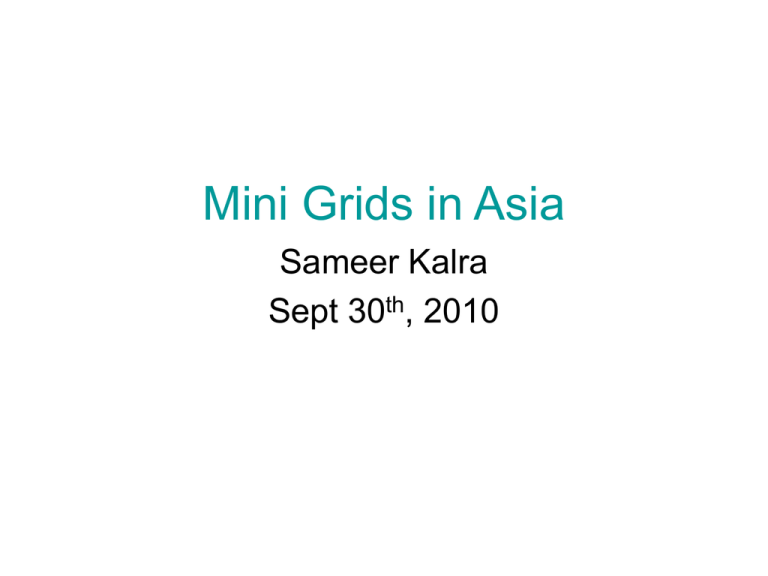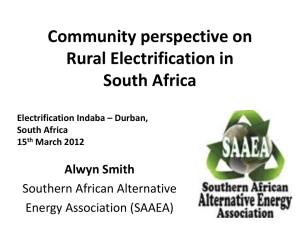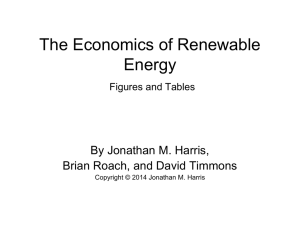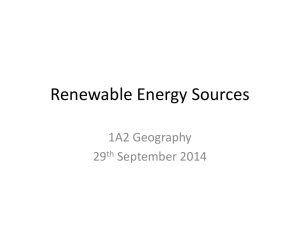Presentation Sameer Kalra
advertisement

Mini Grids in Asia Sameer Kalra Sept 30th, 2010 Mini Grid Definition “An integrated energy system consisting of interconnected loads and distributed energy resources (including generators, energy storage devices, and smart controls) that can operate with the utility grid or in an intentional islanding mode.” World Electrification Facts Source: Alliance for Rural Electrification Developing world remains largely un-electrified. Why Mini Grids? • 1.6 billion people across the developing world remain without electricity – Investment requirements $9.6 trillion in the period 2001 to 2030 • India and China are huge countries with diverse terrains – average cost of grid extension per km between $8,000 and $10,000, rising to around $22,000 in difficult terrains • China builds 1 coal power plant per week • India struggling to bridge gap between supply and demand • Huge electricity cuts in developing counties, to meet peak demand Businesses building Mini Grids to ensure continuous electricity Technology Choices 1. Diesel • • • Pollution – noise / air Non- Renewable – Unsustainable in the long run High OPEX; transportation challenges 2. Solar • • • Most common in Asia – sun is in abundance High CAPEX; ROI is longer Storage issues 3. Wind/Hydro • • • Not suitable for all terrains Transmission between point of generation and consumption Storage issues Hybrid Mini Grids are optimal Technology Decision Tree Source: World Bank Choose the right technology based on ground conditions Critical Factors for Project Success • • • • • Technology choice • Regulatory impact Sustainability • Environmental considerations Financing • Opportunities to Affordability initiate and enhance Community productive activities Involvement and applications Case Study 1 – Scatec Solar Solar PV based Mini Grid in 150 households in India Main challenges • Develop sustainable and scalable business models (with focus on local revenue models) • Develop an effective, global incentive mechanism to facilitate and accelerate a large-scale rollout of CSPPs Project financing • Public private model • CAPEX by Scatec Solar • Tariffs based on the price of kerosene and diesel. • Revenue model = OPEX + renewable components Learnings • Govt and community support is essential • Empowerment and education of local population Project Outcome • Round the clock electricity • Enhance economic activity and productivity Case Study 2 – SMA Solar off-grid power supply for 190 villages Challenge: • Chinese government program to provide rural areas with decentralized power supply systems, mainly PV Renewable Opportunity • Installation of 190 village electrification systems with diesel generator as backup Financing • German Bank of Reconstruction and the Chinese Ministry of Finance Outcome • Modularity of the system allows easy system adjustment to the demands of the energy supplier or the end-users • System integrators like SolarWorld and Schott Solar are adept at connecting these new technologies successfully. Case Study 3 - SolarWorld AG PV-based renewable energy to 7000 homes in China Challenge • Rural Electrification Renewable Opportunity • Good irradiation condition for Solar PV Solution • Multi-crystalline solar PV • Backup diesel generator to reduce battery size Financing • German Bank of Reconstruction and the Chinese Ministry of Finance Outcome • 142 villages with 30,000 people were electrified Case Study 4 – Urban Township in India Townships/Building/Malls Challenge • Intermittent supply of electricity at peak load Financing • Builders such as Reliance, Nano City promoters Opportunity • Supply: storage and distributed generation (renewable and non-renewable sources) • Demand: consumption devices including lighting, HVAC, and IT equipment • Energy management platform: to optimize energy supply and demand • Environmental factors: such as weather, pricing, and comfort Outcome • Developments in planning stages Entrepreneurial Opportunities • • • • Technology Transfer Energy Storage Smart Grids Renewable Integration • System integration, project management • Energy Efficiency • • • • • Carbon Management Building Management SCADA Metering Services S/W for technology optimization More opportunities exist in townships/MDUs rather than in rural electrification Challenges • Scalable and repeatable business models – No cookie cutter models • Land acquisition for solar installations • Cost/kWh for diesel still cheaper than renewable alternatives – Focus on CAPEX versus OPEX • Country-specific utility permitting requirements Questions?











